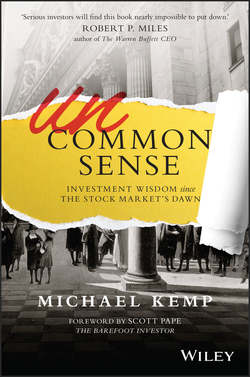Читать книгу Uncommon Sense - Pape Scott - Страница 11
На сайте Литреса книга снята с продажи.
Part I
THE LIMITSOF REASON
2
THE ART OF PREDICTION
ОглавлениеIt was an unusually warm day for a Melbourne winter, one of those sunny days July occasionally delivers – not a breath of wind or a cloud in the sky. I was crossing the pedestrian bridge over the Yarra River that connects Flinders Street Station to the Southbank business precinct. In 10 minutes I would be addressing the clients of a large financial advisory firm. Despite my iPod pumping out Led Zeppelin, my mind was busy running through the presentation.
My presentation was largely about prediction. Audiences love hearing about those big, and very wrong, predictions – the bigger the gaffe the better, and the higher the profile of the ‘gaffee' the better. TV personality economists, presidents, chairmen of the Fed, CEOs – they all make dumb predictions that leave them with egg on their faces. There are books full of their dumb predictions, so there's little point in repeating them here.
Okay then, just a few.
In July 2007 Ben Bernanke, then Chairman of the Federal Reserve, stated: ‘Employment should continue to expand … The global economy continues to be strong … financial markets have remained supportive of economic growth.'
Bad call. The US economy collapsed into recession five months later.
On 17 May 2007 Bernanke had said: ‘We do not expect significant spillovers from the subprime market to the rest of the economy or to the financial system.'
The following year the fallout from subprime triggered the world's worst financial crisis in 80 years.
The irony is that Bernanke was a student of the 1929 Crash. And below is an extract from an editorial published in The Wall Street Journal on 3 September 1929. The Dow Jones Industrial Average had just closed at its all-time peak of 381.17:
Wall Street entered the autumn financial season in a definitely optimistic frame of mind. With railroad traffic showing steady gains, and production in the major branches of industry continuing at a high rate, the earnings prospects of the principal corporations with shares listed on the Stock Exchange were looked upon as extremely promising. Sentiment regarding the credit outlook was reassured by the activities at the Federal Reserve authorities in placing funds at the disposal of business through bill purchases in the open market. With trade and credit conditions favorable, buying orders accumulated in large volume over Labor Day, and the forward movement in the main body of stocks was vigorously resumed in the early dealings … Bullish enthusiasm was stimulated by the return of United States Steel to leadership in the industrial division.8
Like a boat full of oblivious oarsmen rowing towards Niagara Falls, there's not a single hint of imminent danger. The next month the 1929 Crash hit, and less than three years later the Dow had collapsed by 89 per cent.
At the epicentre of 2008's GFC were mortgage providers Fannie Mae and Freddie Mac. On 16 July 2008 Bernanke said that Fannie and Freddie were ‘adequately capitalized' and ‘in no danger of failing'. Just weeks later the US Treasury committed to a $200 billion bailout to save the two insolvent institutions. Financial markets and economies around the world went into a tailspin.
Okay, enough of that. If I keep going we'll be here all day. Back to a more general discussion, starting with those who believe prediction is possible – the Nostradamus set. This type of thinking is exemplified by Harry S. Dent, Jr., who states in his book The Next Great Bubble Boom: ‘Today there is an attitude that nobody can predict the future … that there are too many complex variables that can impact it. But this is obviously nonsense.'9
Could I suggest that what's obviously nonsense is the statement itself? Dent's book doesn't offer any prediction methodology, nor have his own powers of prediction been particularly impressive. For example, in 1998 he forecast the Dow would be between 35 000 and 40 000 by late 2008 or 2009. The time he chose for the peak was slap-bang in the middle of the GFC. By then the Dow had actually plummeted to a low of 6470.
The problem is that we can't deny some degree of prediction. Prediction is central to investing; it's what investors do. They invest money today predicting they'll be delivered more back in the future. So we need to explore the subject of prediction further. Let's start by looking at ‘game theory'.
